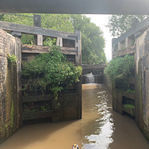-
Posts
5,667 -
Joined
-
Last visited
-
Days Won
10
MoominPapa last won the day on May 10 2021
MoominPapa had the most liked content!
About MoominPapa
- Birthday 11/12/1964
Contact Methods
-
Website URL
http://
Profile Information
-
Gender
Male
-
Location
County Wicklow
-
Occupation
Computers
-
Boat Name
Melaleuca
-
Boat Location
Nantwich
Recent Profile Visitors
19,243 profile views
MoominPapa's Achievements
Veteran II (12/12)
1.2k
Reputation
-
MoominPapa started following Canals and Water Shortage , Chester to Ellesmere Port CLOSED , South Oxford closing soon and 6 others
-
That's the last route from the Weaver to the rest of the world gone then. Better start digging from Winsford towards the Middlewich branch. MP.
-
Surely the Calcutt pump discharges into that pound? MP.
-
I misspoke above: it was Curdworth top that we had to run water down. I think that was just because there had been no movements through the top lock and nothing going down the bywash, so the pound below the top lock had leaked down. Why the five miles from Minworth to Curdworth was, and still is, so low is a mystery to me. Faulty pumps keep getting mentioned (and were to us in February) but where are these pumps? Surely the supply to that section comes from Birmingham via Aston, Garrison and Perry Bar? Just outside the tunnel is definitely the shallowest spot in the pound. Spot dredging there would massively improve its resilience to low levels. MP.
-
Whatever is causing this, it isn't the lack of rain and hot weather. The same problems were present in February when we came through and spent a day stuck on the lump downstream of Curdworth tunnel, and then had to run a load of water down Minworth top lock to get under the bridge by the old wharf. MP.
-
Repeating granny/eggs. But all of these I've seen, the bar _raises_ as the terminal is tightened, so the bottom of the tunnel is irrelevant. The terminal is open when the screw is fully anticlockwise and the bar is at the bottom, furthest away from the side where you insert the screwdriver. Put the wire in and tighten the screw clockwise. The bar raises and clamps the wire between the bar and "top" of the tunnel. MP
-
Apologies if I'm teaching granny to suck eggs, but are these terminals the "stirrup" type, where the screw moves a square hoop of of metal? The actual terminal and the incoming wire go in the centre of the hoop and as the screw is tightened, the loop moves and the wire is caught between it and the terminal. When the terminal is open, you see a hole with a bar of metal across it, and it's remarkably easy to get the wire on the wrong side of the bar, with the result that the wire is not clamped at all when the screw is tightened, especially when you can't actually see the hole the wire goes into. The best way to get this right is to back the screw off all the way. Then the bar is all the way to one side of the hole, and you can't accidentally get the wire on the wrong side of it. MP.
-
I could have done, or I could have claimed on my own, comprehensive, insurance and my insurance co could have claimed the costs back from the owner of the sunken boat. But he was a fellow moorer who had just had his boat trashed and no recompense, so I didn't feel like kicking a man who was down. The lesson is to have comprehensive insurance, that solves the problem if you are the third party; it becomes your insurer's problem. Agreed. When I found out about this we were boating in the Fens and I remember thinking one day whilst waiting for Salter's Lode lock to empty that if the boat sank halfway out of the lock, stopping the guilotine gate from sealing, everything for miles behind me would be flooded as the tide came in, and I would be on the hook for the whole lot if the insurance co. could prove that the sinking was due to faulty maintenance. MP.
-
There's a subtle misunderstanding here. It's not that boat insurance policies don't cover third party liabilities (they have to, in law) , it's that they don't cover third party liabilities if the insurer breaks the contract of insurance. Examples may make this easier to understand. If I get into my comprehensively insured car pissed as a fart, set off down the M1 and crash into another car, the insurance company will not pay out for the damage to my car, even though it's comprehensively insured. That's because the accident was caused by my negligence and there's a clause in the insurance policy that covers that eventuality. It will, however, still have to pay out for the damage to the car I hit, because the road traffic act says it must. If my boat sinks because I haven't maintained it and there's a rust hole in the gas locker floor, the insurance company will similarly not pay out, because there's a clause in the policy that says the boat must be maintained and it wasn't.. The difference to the car example is that if the sunken boat leaks the contents of the diesel tank and strips the blacking off the waterlines of marina full of boats, the same clause atill renders the policy void, and the insurance company will not pay for the third party owners of those boats to get them re-blacked. The first example is hypothetical, the second definitely happened to me (I was one of the third parties). The clause in the British Waterways act analogous to the one in the road traffic act that says BW and it's successors can insist on third party insurance is the same as the one in the road traffic act, except that it misses out the stipulation that third party cover must be unconditional. To the best of my knowledge all marine insurance policies take advantage of this. When I was affected it was certainly the case that the sunken boat's insurance did, and I asked my insurers and the same was true of them. MP. ETA. The relevant part of the RTA is section 148. There is no analogous clause in the BW act.
-
The legislation for motor vehicle insurance mandates this cover for third parties. The corresponding legislation for boat insurance doesn't. If you read the relevant clauses in the two laws, it's clear that they are copy-and-paste, but the bit about third parties has been removed from the British Waterways act, or added to the road traffic act. Motor vehicle insurance is not, therefore, a "closer fit". It would seem to be, and it surprised me when I found out it wasn't, but that is certainly the case. MP.
-
Battery charging is a chemical reaction, and (most) chemical reactions get exponentially faster as the temperature increases. See: the Arrhenius equation. MP.
-
Grants lock bottom gate was warped and only just opening enough to get a boat past when we went south last week and when we returned a couple of days ago. It's possible someone go a bit too enthusiastic trying to push a slightly fat boat past, or had too many people leaning on the balance beam to get the last half inch of opening. Or someone failed to stop whilst entering the lock when full and just hit it. Given the level of fuckwittery I've witnessed going to Oxford and back, nothing would surprise me. If this one doesn't get you, Pigeon Lock probably will. One top paddle in action; takes 30 minutes to make a level. The pound between Slat Mill and Bourton locks that was empty last week is still low, probably because the cill at Bourton is basically blown and the bottom gates leak so much that it still leaks down fast, even with the blown cill filling it. On the other hand, ignore the closure notice for Duke's cut. The top paddle is US, but the top gate leaks so much that it makes a perfect level in 15 minutes. Twice as fast as Pigeon! MP.
-

Braunston Junction (and pound) low water levels
MoominPapa replied to Lily Rose's topic in General Boating
Melaleuca is at our new mooring at Shuckborough, which is a bit short of depth. We got the boat last night and found her sitting pretty much flat on the mud with the level maybe four inches lower than the tide mark on the hull. Hoping they fix this otherwise we're going to need a snatch to get off the mud into the channel. Unexplained low pounds does seem to be a bit of an epidemic. I suspect the number of people on the ground sorting stuff out is much reduced. MP. -
Again? End of Feb, we were stuck for a day on the shallow lump downstream of Curdworth tunnel and then had to spend an hour running water down Curdworth top lock to get enough in the next pound to grind under the bridge. CRT told us the problem was a pump down, but nobody here can see how that pound is supplied by a pump. Looks like the problem is ongoing. MP.
-
This post cannot be displayed because it is in a forum which requires at least 10 posts to view.














